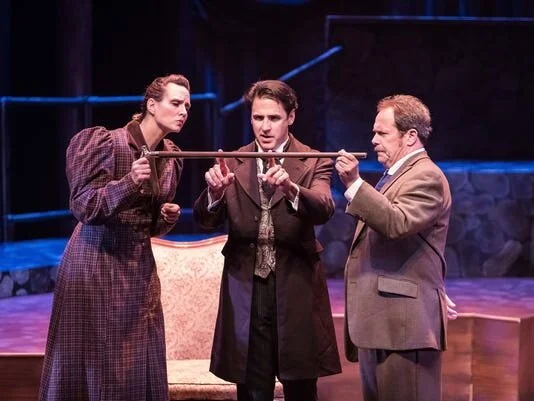Meadow Brook nails the laughs in 'Baskerville'
Cheryl Turski, Ron Williams, and Phil Powers in "Baskerville: A Sherlock Holmes Mystery" at Meadow Brook Theatre. (Photo: Sean Carter)
John Monaghan, Special to the Detroit Free Press
Two of Meadow Brook Theatre’s sturdiest traditions — the murder mystery and the horror-themed October season opener — survive and thrive in “Baskerville: A Sherlock Holmes Mystery.” Ken Ludwig's 2015 comic whodunit makes its Michigan premiere with a crack cast and able support behind the scenes.
The play, based on Sir Arthur Conan Doyle’s turn-of-the-last century yarn, begins with the death of Sir Charles Baskerville (Peter Prouty) while he's being chased by a huge, snarling creature that he sees but we don’t. It's then up to master detective Holmes (Ron Williams) and his faithful assistant, Dr. Watson (Phil Powers), to turn the coroner’s report from heart attack to murder.Holmes and Watson have a handful of suspects, but they spend most of their time trailing the estate’s heir, Sir Henry Baskerville (David Wolber), a Texan of the yee-haw variety. Watson, as in the original story, does much of the work, as it is he who accompanies Sir Henry to the castle and the adjoining moors, where a series of strange events takes place.
Ludwig, best known for works like “Lend Me a Tenor,” “Moon Over Buffalo,” and “Crazy for You,” doesn’t take the proceedings very seriously. Neither should we. In fact, you might say that “Baskerville” isn’t so much about Holmes and Watson as the nearly 40 supporting characters who are dexterously played by three of the play's five cast members.
At one moment, Prouty and Cheryl Turski are cast as a pair of Dickens-like cockney boys who help Holmes run down clues. At the next, they're the brother-and-sister neighbors near the Baskerville estate. He spends his days prancing around the moors with a butterfly net while she tries to snag the lovestruck Sir Henry.
Other standout characters and moments include the lugubrious caretakers of Baskerville Hall (Prouty and Turski again) and Wolber’s inspired turn (or turns, as you’ll see in the final act) as the Scotland Yard inspector Lestrade.
Costume designer Liz Goodall, whose work nicely evokes the Edwardian period, gets some of the credit for the blink-of-an-eye character changes. You may be tempted to see the play a second time just to figure how the actors make those exits and entrances so fast.
If Williams seems as at home in the title role as Holmes is in his smoking jacket, it’s because he played the role a couple of seasons ago in Meadow Brook’s 2013 offering “The Game’s Afoot.” He connects well with Powers’ Watson, who reluctantly allows himself to be placed into one dangerous situations after another.
The fog machines work overtime on Jen Price Fick’s elaborate and atmospheric set. Framed on both sides by bookcases that stretch from floor to catwalk, her organic, tri-level stage gives director Travis W. Walter a flexible space to tell a complicated plot that only thickens with each new character.
To both Ludwig's and Walter’s credit, “Baskerville” manages to keep the audience guessing through the entirety of 2½ hours, and it stays closer to the original story than you might expect. (Some of the jokes fall flat, however, and others drag on way too long.) For me, there was a surprising amount of emotional investment in the affable Sir Henry, who goes from being Watson’s prime suspect to a trusting friend.
Meadow Brook is hardly a stranger to plays that call for actors to juggle roles. The company performed similar magic in previous seasons with “Around the World in 80 Days” and “The 39 Steps.” Ludwig, who has been selective in choosing venues for early productions of his new play, should be more than satisfied with this well-oiled staging.

